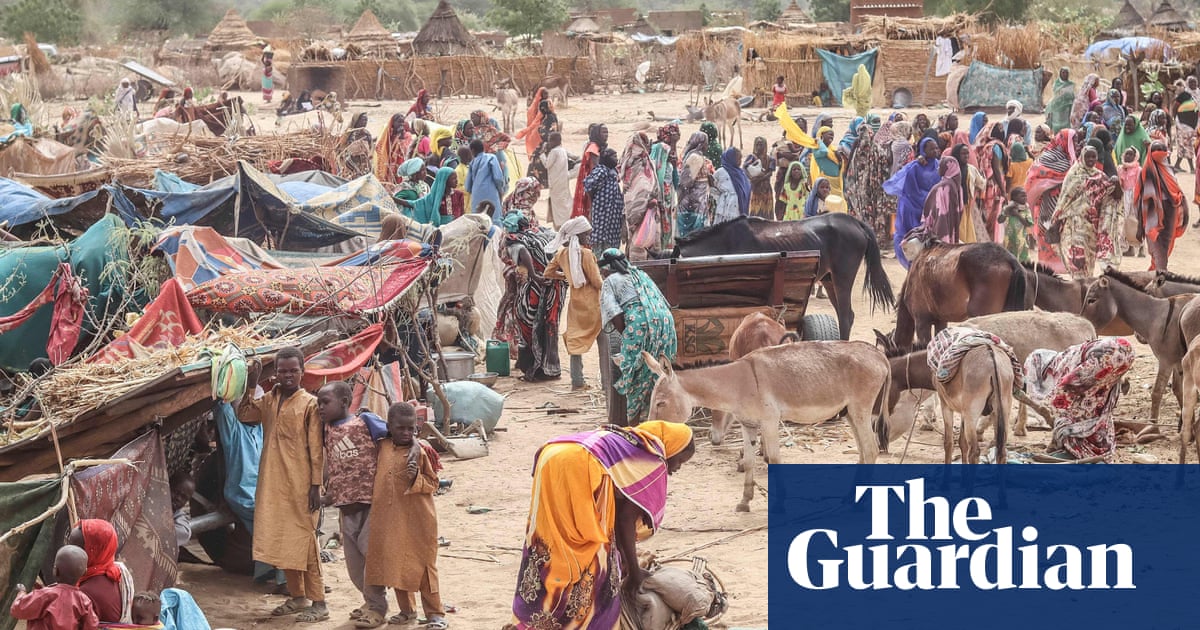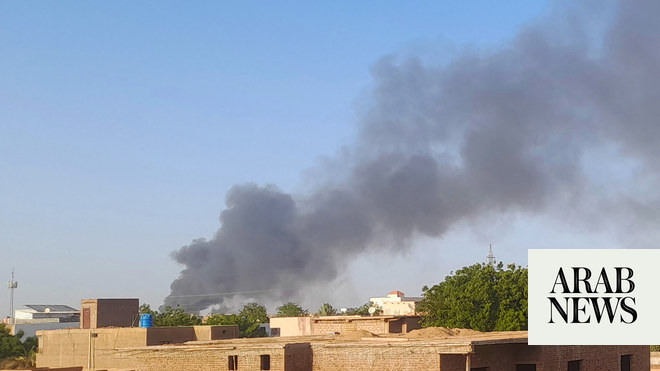
The UN is in a race against time to get food supplies to Sudanese refugees crossing the border into Chad before the rainy season begins, as neighbouring countries struggle to cope with the numbers of people fleeing the civil war.
More than 110,000 people are now estimated to have crossed into other countries as patchy ceasefires fail to stop deadly clashes between Sudanese army troops and a paramilitary rival that have killed hundreds and forced more than 330,000 from their homes.
But, in a region suffering acutely from hunger and already hosting sizeable refugee populations with vastly decreased funds, aid workers are warning there are serious questions over what awaits the new arrivals once they cross the border.
In Chad, where more than 30,000 people have arrived since the fighting began in mid-April, the UN’s emergency food assistance programme is planning for as many as 100,000 new refugees to arrive over the coming weeks and months.
But the imminent rainy season threatens to cut off remote border regions and means it is essential that food stocks are “pre-positioned” now in strategic locations, such as in Farchana refugee camp in the east, warned Pierre Honnorat, Chad spokesperson for the World Food Programme.
“The rains are coming … and in six to eight weeks the roads will be hardly passable. Which is why this is a race,” he said. It is also only weeks until the start of the lean season between harvests, which was already expected to leave an estimated 1.9 million people severely food insecure.
Chad, which was home to 580,000 refugees of various nationalities before this latest conflict, ranks second to last in the UN’s Human Development Index (HDI).
Last is South Sudan, where almost 30,000 people have arrived in recent weeks, most of them returning to a country they fled during a brutal civil war. Central African Republic, which has received about 6,000 refugees, is the world’s fourth least developed nation.
Matthew Saltmarsh, spokesperson for the UN refugee agency, UNHCR, warned this week that humanitarian operations in Sudan’s neighbouring countries were already “hugely underfunded” and needed the international community to raise money and “help us get aid into those areas where it’s desperately needed”.
In Ethiopia, where more than 10,000 people are understood to have crossed into Amhara, until recently caught up in the violent overspill of a war between government forces and Tigrayan rebels, WFP recently cut its rations for refugees by 40%. The agency is preparing to provide monthly rations to the new arrivals but needs additional funding to do so, a source said.
In Chad, Honnorat recalled that the day before the conflict erupted he had issued a press release warning the agency had “absolutely no funding from May onwards” for refugees and the internally displaced. WFP now estimates it needs $160m (£127m) to be able to provide food over the next six months for the new refugees, as well as those it was already supporting.
About two weeks into the conflict there had been a big change in the needs of people crossing the border, Honnorat said. To begin with, many refugees had been coming from just across the border in Darfur and had arrived with food to last three or four days, as well as other possessions. For the past five days or so, however, people from further away have been arriving, “and they are coming with nothing … They’ve just run away.”
In South Sudan, where returnees are crossing mainly into Upper Nile State near Renk, the limits of what the country can offer those fleeing is starkly apparent within hours of arriving, according to aid workers on the ground.
“The big issue is that what they’re coming back to is a very difficult situation,” said Charlotte Hallqvist, UNHCR spokesperson for South Sudan, speaking from Renk. “Many are getting stuck at the border because there’s basically no connectivity there. There are no services either. Even getting to Renk is about an hour’s drive and that is the nearest town.”
Many of those arriving at the border “have walked long distances, they have been on these donkey carts, exposed to the sun, heat, etc. They’re arriving in a really bad condition,” Hallqvist said. UNHCR has set up a transit centre where people can access water, food and medicines, but it has already reached its 5,000 capacity and the border and Renk town are becoming extremely congested.
“The problem is that even if people are able to move themselves off the border, infrastructure in South Sudan and transportation is incredibly limited … Climate change and flooding has devastated the existing road infrastructure. So getting out of this area is really difficult,” said Hallqvist. “For those people that are desperate to get out, even if they have the means, it is very difficult. But the reality is that so many people also don’t have the means to pay for transportation out of here.”
She had met a family in Renk, she said, who wanted to go to their ancestral home in Northern Bahr el Ghazal region, hundreds of miles across the country in the far north-west. “It’s going to be almost impossible for them to get there … By road it’s impossible. They would have to fly somehow to Juba and then from Juba get another flight, and those means of transportation are just out of reach for the majority.”
Even if they did manage to reach their destination, she added, the UN is concerned about the impact their arrival will have. “Because the reality is that many of the communities that people want to go back to are already very, very fragile, because of conflict, climate change, food insecurity, etc. So if they’re able to make it back, what is there for them?”
The dire economic situation of many of those fleeing is not going to be helped by the inflation reported in parts of landlocked South Sudan, CAR and Chad as a result of the fighting. “A lot of imports were coming from Sudan and the big towns like El Geneina [in Darfur]. That is totally paralysed now and it is putting strain on markets for any goods: sugar, oil, cereals, etc,” said Honnorat.
“So you have the commercial activity that is stopped, you have the prices on the market that are rocketing, you have a big pressure on the host community, and all those new refugees. It’s bad and we don’t know how many more will come. This is the big issue.”
South Sudan
Number of arrivals: An estimated 30,000 people have entered, most of them South Sudanese refugees who have returned to their home country.
Pre-existing refugee/IDP population: About 330,000 refugees and asylum seekers (mainly from Sudan), and 2 million internally displaced people.
Many of those who fled north when their country became engulfed in violence during the 2013-20 civil war are now coming back. But to what? South Sudan is the least developed country in the world, according to the UN, and has some of the worst health indicators as a result, as well as limited infrastructure and continuing low-level instability. Many returnees are suffering “re-traumatisation” through “coming back to the country where civilians were brutalised”, said Hallqvist.
Egypt
Number of arrivals: About 40,000 Sudanese and 2,300 foreign nationals.
Pre-existing refugee/IDP population: More than 288,000 registered asylum seekers and refugees, the majority from Syria, followed by Sudan and South Sudan.
So far, most Sudanese who have managed to flee internationally have done so to their northern neighbour. Many are arriving “traumatised, having lost family members, friends and loved ones in the blink of an eye”, says Christine Beshay, UNHCR spokesperson in Egypt. “They are in dire need of a wide range of assistance and services, given that they fled with barely anything.” A steep decrease in the exchange rate of the Sudanese pound against the Egyptian pound in the unofficial exchange rate market has proved an additional hardship.
Chad
Number of arrivals: More than 30,000.
Pre-existing refugee/IDP population: 580,000 refugees from conflicts in Sudan, CAR and Cameroon, as well as about 400,000 IDPs.
One of the big refugee host nations, Chad has long provided a form of refuge to Sudanese fleeing the violence of the past few decades. However, it also has plenty of its own problems, including some of the highest poverty rates in the world, a lingering Boko Haram jihadist insurgency and, last year, mass flooding. In other words, a country “already under super-tension”, said Honnorat.
Central African Republic
Number of arrivals: About 6,000, including Sudanese refugees and returnees.
Pre-existing refugee/IDP population: More than 480,000 internally displaced people.
Chronically volatile and suffering high levels of food insecurity – about 120,000 people are in need of humanitarian assistance in the north of the country – CAR is exploring the possibility of relocating new arrivals away from the border region. The country is seeing an increase in the price of goods due to supply chains through Sudan being disrupted. Sugar and millet have reportedly doubled in price since the fighting began.
Ethiopia
Number of arrivals: More than 11,000, mostly Sudanese, but also Eritreans, returning Ethiopian refugees and others.
Pre-existing refugee/IDP population: More than 823,000 refugees and asylum seekers predominantly from South Sudan, Somalia and Eritrea.
Not long recovered from a bloody war between Tigrayan rebels and troops loyal to prime minister Abiy Ahmed, Ethiopia could receive up to 85,000 people fleeing the violence in Sudan, according to the UN. Some would stay in Amhara, while others would be moved elsewhere including, if the security situation permits it, Shire in western Tigray.












